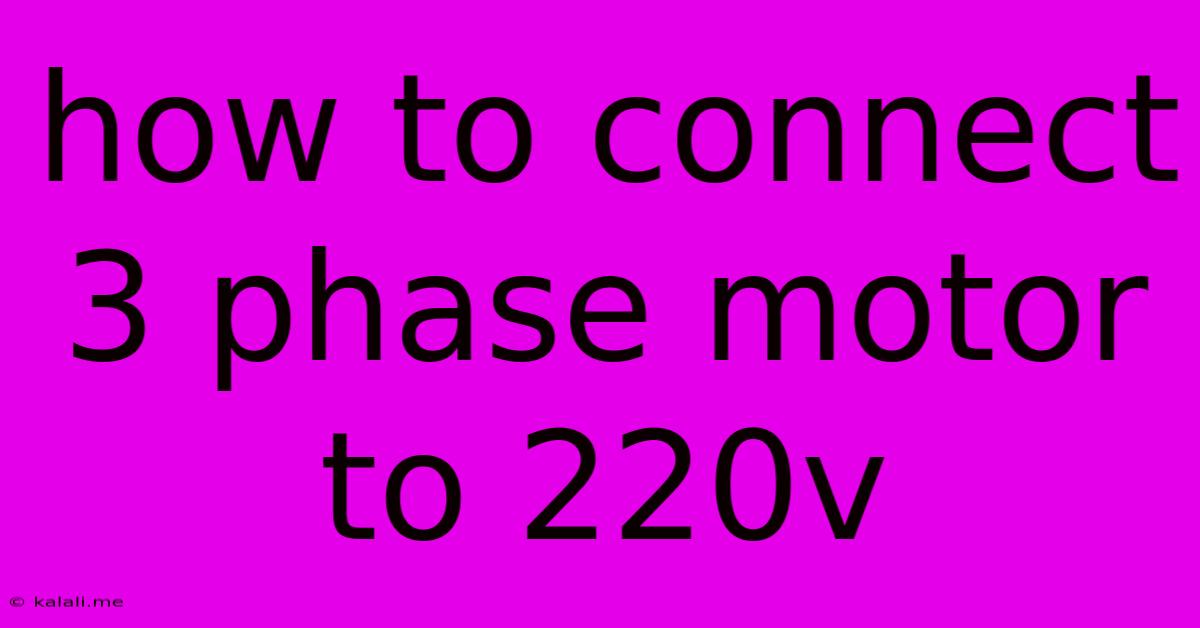How To Connect 3 Phase Motor To 220v
Kalali
May 28, 2025 · 3 min read

Table of Contents
How to Connect a Three-Phase Motor to a 220V Supply: A Comprehensive Guide
Connecting a three-phase motor to a single-phase 220V supply isn't a straightforward task like plugging in a lamp. Three-phase motors are designed for a three-phase power source, offering superior performance and efficiency compared to single-phase motors. However, if you only have access to a 220V single-phase supply, you'll need a phase converter. This article explains the process and the considerations involved. This includes understanding the risks and safety precautions you must take before attempting this.
Understanding the Challenge: Three-Phase vs. Single-Phase Power
Three-phase power consists of three alternating current (AC) waveforms, each 120 degrees out of phase with the others. This provides a more consistent power delivery and higher torque compared to single-phase power, which only has one waveform. A three-phase motor relies on this balanced power distribution for its operation. Connecting a three-phase motor directly to a single-phase supply will result in improper operation, potential damage, and safety hazards.
Solutions for Connecting a Three-Phase Motor to a 220V Single-Phase Supply
The only reliable way to run a three-phase motor on a single-phase 220V supply is by using a phase converter. Phase converters simulate a three-phase power supply from a single-phase input. Several types exist:
-
Static Phase Converters: These use capacitors or other electronic components to create the missing phases. They are generally suitable for smaller motors with lower power requirements. They are often less expensive but may introduce harmonic distortion and reduced efficiency.
-
Rotary Phase Converters: These use a motor-generator set. A single-phase motor drives a three-phase generator, producing the necessary three-phase power. They offer better performance and are better suited for larger, higher-power motors. However, they are typically larger, more expensive, and require more maintenance.
-
Variable Frequency Drives (VFDs): While primarily used for motor speed control, VFDs can also convert single-phase power to three-phase power. They are highly efficient and offer sophisticated control features. They are generally the most expensive option but are often the best choice for demanding applications.
Choosing the Right Phase Converter: Factors to Consider
Selecting the appropriate phase converter depends on several factors:
-
Motor horsepower (HP): The higher the horsepower, the more powerful and robust the phase converter needs to be.
-
Motor starting torque requirements: Some applications require high starting torque. A rotary converter typically provides better starting torque than a static converter.
-
Budget: Static converters are typically less expensive, while VFDs are the most costly option.
-
Efficiency requirements: VFDs offer the highest efficiency, followed by rotary converters, and then static converters.
Safety Precautions: Always Prioritize Safety
Working with electricity can be dangerous. Before attempting to connect a three-phase motor to a single-phase supply, take these crucial steps:
-
Turn off the power: Always disconnect the power supply to the circuit before working on any electrical connections.
-
Use appropriate safety equipment: Wear insulated gloves, safety glasses, and appropriate footwear.
-
Consult a qualified electrician: If you're not comfortable working with electricity, consult a qualified electrician to perform the connection. Improper wiring can lead to serious injury or damage to equipment.
-
Understand the wiring diagram: Carefully review the wiring diagram for both the motor and the phase converter.
-
Check for proper grounding: Ensure that the system is properly grounded to protect against electrical shocks.
Conclusion
Connecting a three-phase motor to a 220V single-phase supply is achievable using a phase converter. However, careful consideration of motor specifications and the selection of the correct converter are crucial. Always prioritize safety and seek professional assistance if needed. Improper installation can lead to equipment malfunction, inefficiency, and even serious injury. Remember to choose a converter that matches your motor's requirements for optimal performance and longevity.
Latest Posts
Latest Posts
-
How To Install Tankless Water Heater
May 30, 2025
-
Is Another Word For Absolute Value Sum
May 30, 2025
-
Do Panko Bread Crumbs Go Bad
May 30, 2025
-
How To Remove Labels From Wine Bottles
May 30, 2025
-
Can You Lay Vinyl Flooring Over Tile
May 30, 2025
Related Post
Thank you for visiting our website which covers about How To Connect 3 Phase Motor To 220v . We hope the information provided has been useful to you. Feel free to contact us if you have any questions or need further assistance. See you next time and don't miss to bookmark.